Posts Tagged Ea
The Logos Walks the Earth
Posted by Kim Graae Munch in Esoterics, Hinduism, Indian esoteric, Kabbalah, Rosicrucianism, The Holy Grail on April 13, 2018
“The greatest untold story is the evolution of God.”
― G.I. Gurdjieff
I have here a text by Rudolf Steiner where he describe the three Logoi. I have added other quotes by Steiner and my own comments and diagrams.
The Three Logoi
There are three godly creative powers in the universe, the three Logoi: In Kabbalah they are called the Father, Mother and Son and in Christianity they are called Father, Son and Holy Spirit. It’s different terminology, but the underlying reality is the same.
The Father, Mother and Son symbology describes the creative type in relation to the creation and higher Logoi. The Mother is of course the Creator of humankind. The Father gives the idea, the Mother gives life and the Son gives form. The Trinity defines their role in the creation. See more on this aspect in Sophia – Creator of Humankind.
The First Logos creates out of nothing, creates Consciousness. The Second Logos creates new Life out of the existing and guides the living. The Third Logos combines the created, the building blocks, the clockwork of the microcosmos.
Rudolf Steiner has written this text on the three Logoi, but I must admit I didn’t understand the text before I had worked it out for myself. Its very short and he doesn’t give any details or examples, but I think it’s one of the deepest secrets he has hidden here for us to find. I think it’s about time it becomes known.
From Steiner’s Foundations of Esotericism, lecture 27:
Here we have three definitions of Beings who bring about, who underlie a planetary chain. They are called the three Logoi.
• The Third Logos produces by means of combining.
• When out of one substance something else having new life comes into being, this is brought forth by the Second Logos.
• Everywhere, however, where we have to do with a coming forth out of nothing, we have the First Logos.
This is why the First Logos is also often called the One who is immanent in things, the Second Logos the One who in the quiescent substance in things creates life out of the living, the Third Logos the One who combines everything existing, who puts the world together out of things.

These three Logoi always manifest in the world in and through one another.
…
In contemplating the world one continually sees the interaction of the three Logoi.
When a new creation starts, a new Æon, the First Logos sacrifices himself by falling down to a lower level. An archangel becomes an angel by adding an etheric body as a lower body.
The first logos is related to the second, as when, standing in front of the mirror image, we undertake to give our own life to the mirror image. The surrender of life is the original sacrifice in free action. That is the act of the first logo.
The second logos is exactly the same as the first logos, except that it was given its existence by a sacrifice. If one now studies the effect of the second logos, one finds that the essence of the second logos is that it radiates the essence of the first logos back to the first logos.
Thus, the second logos is a reflection of the first logos from which he received his own life, the life that emanated from the first logos.
The lecture series Foundations of Esotericism contains gold nuggets not found elsewhere. Not all versions of this text are good or contain all the pictures. This I think contains everything.
When Christ as First Logos sacrificed himself in the Saturn Æon when he took an astral body as the lowest body he became an archangel. On the old Sun he created Lucifer as a mirror image of himself, the Second Logos, and Lucifer became the first true being of the archangelic hierarchy.
The First Logos encircles the creation, the Second Logos enters the reality. It splits in two, a female part like Sophia or Eve and a masculine part like Anthropos or Adam, and like a potter the one hand forms the pot from outside and the other from within.
Now we have a binary in the Second Logos. The life and content of the Second Logos are twofold. The content is the same as the First Logos, but life is different than the First Logos.
The dash in the middle of the second circle means that in the Second Logos life and content are twofold, that they are divided. When it comes to content, image and mirror image are the same for both, but life is twofold. ~Steiner.
First, the First Logos is reflected once again, secondly, the reflection is reflected. This then gives the Third Logos as the reflection of the other two logoi. So it contains the Third logos:
• the mirror image of the First Logos
• the mirror image of what the First Logos in the Second Logos did, namely his life
• The mirror image of what the Second Logos reflects back to the First Logos.
Let us now imagine: The First Logos is mirrored in a. If the First Logos is the creative activity that strives outward, then its reflection in the Third Logos is just the reverse activity of the First Logos. In the First Logos, a is the highest spiritual world light: in the Third Logos, a is the ultimate spiritual darkness.
ln the Second Logos, b is the life that the Second Logos received from the First Logos. It is not the life that sacrifices itself, but the one that has been accepted. The life that sacrifices itself in the First Logos is love. The opposite of this in the Third Logos is the absolute desire, longing, striving for logos, b is therefore the absolute desire in the Third Logos.
In the Second Logos c is the mirror image of the First Logos, which reflects the Second Logos.
• What we have surrendered comes back as desire.
• The image itself, which we ourselves are.
b the absolute desire = Rajas
c the simple reflection of the first logo = sattva
Tamas, Rajas, Sattva are the three gunas, the three parts of the Third Logos. ~Steiner
First, a, b and c are present.
• If a alone exists, it is Tamas.
• When a – the spiritual darkness or Tamas – combines with b – rajas, the absolute desire – darkness combines with desire, and it is a striving for the first logos.
• When a and c – Tamas and Sattva – are combined, we have created the image of the first logo out of the darkness.
• Likewise, we can combine b with c. It can each occur individually and be combined with one of the others.
• All three combined are what the first logo itself is.
We have seven possible combinations of the three gunas:
So these are the seven different combinations of Gunas. Imagine these seven possible combinations as the next world-creative principle that can emerge from the three Gunas. These seven entities really exist. They are the so-called seven creative spirits before the Throne of God, according to the three Logoi the seven nearest creative powers:
Seven creative spirits, which Jacob Boehme calls the seven spring spirits in his aurora, spring from the third logos, for all three activities of the third logos can work together, or in pairs two or each: there are seven combinations that appear essential, and of which the one that encompasses all three activities is the third logo itself. Thus, the next level is reached world-creative beings. ~Steiner.
I have used a drawing of Steiner to show this information, the Alchemist Mountain. It’s a versatile diagram that can be used to show many aspects of man, gods and the universe. It corresponds to the seven lowest sephira in the Kabbalah Tree of Life. Here put together with the Seven Creative Spirits and the Æon’s:
These seven world-creative principles correspond to the seven planets but also to the Planetary development cycles, Æons, the incarnations our Earth goes through, but also the shorter development periods follow this sequence. See more later.
In the old Saturn æon the seed of the physical body and Atma was created. This is the Father. In the old Sun æon the seed of the etheric body and Buddhi was added. This is the Son. On the old Moon the seed of the astral body and Manas was added. This is the Holy Spirit.
The astral is the most flexible layer, most conscious, and therefore easier to transform. The etheric layers consciousness is not as flexible so it’s less easy to transform. And the physical layer is the least flexible and therefore most difficult to transform.
Atma need all three layers (abc) to develop before it can be developed, and the consciousness soul is the channel developed.
Development of the spiritual bodies:
ac • The Spirit Self or Manas is the result of the experiences of the physical body (a) transforming the karma of the astral (c).
bc • Life Spirit or Buddhi is our wisdom, the result of the transformation of our etheric body (b) our opinions by the speculative thinking of the astral body (c).
abc • Spirit Body or Atma is the result of the transformation of the physical (a) by the work of the Etheric (b) and the astral (c).

Through the work in the physical and the etheric we create the soul. Through the work in the physical and astral we create Manas, develop the higher I. Through the work in the Etheric and Astral we create Buddhi, wisdom. Through the work in a, b and c we create Atma, the resurrection body.

They are the foundation behind all creation. We know them most visibly through Osiris, Isis and Horus, but usually the Logoi are hidden under a veil of mystery.
In every creation a being is selected to become the coming Logos for that creation, being the archetype for the rest of the creation. Already from old Saturn was the creating Word of humanity selected and prepared for the role.
This creating downwards is shown in Kabbalah where the Sephirots, the Logoi, are created downward. When the creation develops and raises, the Logos follows its siblings up. The Logos is like a sun in the creation, in the hierarchy.

The Tree of Life
In Christianity the archangel names are titles for the Logos at a given hierarchy. Steiner compares the great archangels to the other members of the angelic hierarchy as the sun to a planet.
The Messenger of God, Archangel Gabriel, is the Logos of the Angels. The Face of God, Archangel Michael, is the Logos of the archangelic hierarchy. The archangelic hierarchy should not be confused with the great archangels.

The Gods walk the Earth
This describes the Logoi in the Earth development, and less the actual details, I have another text describing more detailed here: Esoteric Earth History.
The Three Logoi is known through many symbols, here we have a number of such:
Steiner mentions that Zarathustra is the Second Logos, one of the three main teachers of mankind. These high spiritual powers work on Earth:
High spiritual beings whom we call masters stream down to us.
We should realize that it’s mainly they who guide us and are near to us in meditation.
We should also know that they walk on earth incarnated in a physical body.
The Symbology and Meaning of AUM
Adam and Eve – Anthropos and Sophia
In Genesis we have Adam as the first creation by Sophia, the physical world. Eve is the second creation, in who Sophia emanates into. Adam is the First Logos and Eve is the Second Logos, and Cain is her masculine side entering the physical universe as Yaldabaoth where Eve takes care of the spiritual side.
Cain is the Son of God, the Second Logos, who are the archetype of humankind, who develop life on Earth from the smallest cells to the human body, and the spiritual bodies, walking the path just before we walk it.
Abel is the Son of Man, the Third Logos we know as Jesus, he is a reflection of Adam and Eve, the Second Logos.
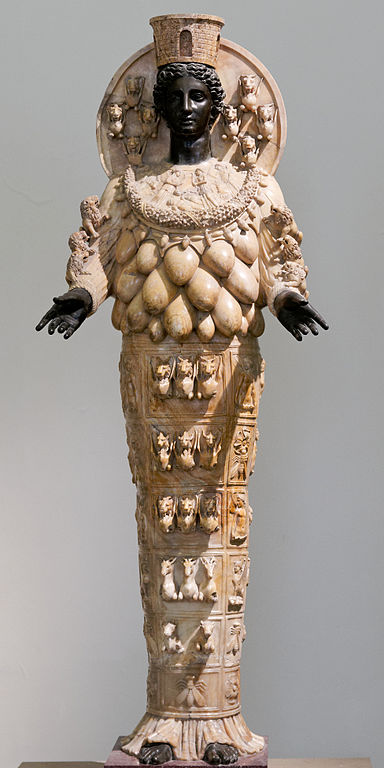
At the start of Earth Sophia was the etheric planet where all life was connected through tubes where prana feed all beings.
She took on the physical as outer body, that became more and more solid until she once became fully coated by physical materia.
The Second Logos developed all the physical life on Earth from one celled life until human life. The Second Logos was in form of the archetypal pair the only one incarnating around the end of Lemuria and the start of Atlantis.
The Earth and its life was fully covered in the physical stuff at the end of Dream Time, when Krishna died from mankind’s view, when the Dark Time, Kali Yuga, started. Sophia left the physical and raised to angel, Theosophia.
The First Logos was Zarathustra, Odin, Zeus, Noah, Elisha, and many more through whom Sophia worked.
Krishna teaches Arjuna, the Second Logos, to lead humanity on after the Dark Night, Kali Yuga, falls over the Earth. Krishna puts on paper the knowledge that people could see in the spiritual world, so it survived into the coming Dark Age. See Krishna and the Holy Spirit.
Arjuna learns that Krishna will not interact directly any longer in the human affairs, Krishna will in the future work through Arjuna. But even if Arjuna is one against all Krishna will make sure that he wins, through the wheel of fate, the Zodiac.

Krishna with the Wheel of Fate.
Christ Jesus
The First Logos is also known as the personality of Zarathustra, with the prime objective to develop the I, and preparing mankind to live in a purely physical world.
Jesus of Nazareth is a very highly developed individuality. In the thirtieth year of his life he gives up his own life to the descending Christ, the descending Logos. All this the Magi foresaw. The great sacrifice made by Jesus of Nazareth is that he gave up his ‘ I ’ to make way for the Second Logos. ~Steiner
With Jesus incarnated the Third Logos, the Son of Man, Abel, the one who stayed back. In the Son of Man is the creation descended a level deeper into the physical, by him the astral body is the fourth principle, where the I will be developed, where we had the I in the soul, in the intellectual soul, a purification of the etheric soul.
Steiner mentions that he as child he spoke a language only his mother spoke, who represents Sophia. It was dream language they spoke, the language spoken between the astral body and the higher I.
The following text also points to the Jesus being as the Holy Spirit, awaiting the time to incarnate:
The spirit that prevailed in the common origin of both souls and bodies is the father spirit; that is the “Father”.
The spirit that prevailed down below in the physical realm, whilst the spiritual went its separate ways up above, is the son spirit; that is the “Son”.
And the spirit that prevailed up above in the soul sphere until it was able to descend into the physical realm, that is the “Holy Spirit”.
From the notes of the lecture “The promised spirit of truth”, Cologne, 8 March 1907
The body of Jesus became one with the Earth, he didn’t leave the grave again, the Third Logos entered the earth.

When Christ left the Sun he left the highest member Atma behind so the highest body was the Buddhi, and attained the elemental body of type I as the lowest. He is the Archetype of the new humanity that will go through the human development on New Jupiter, also called New Jerusalem.
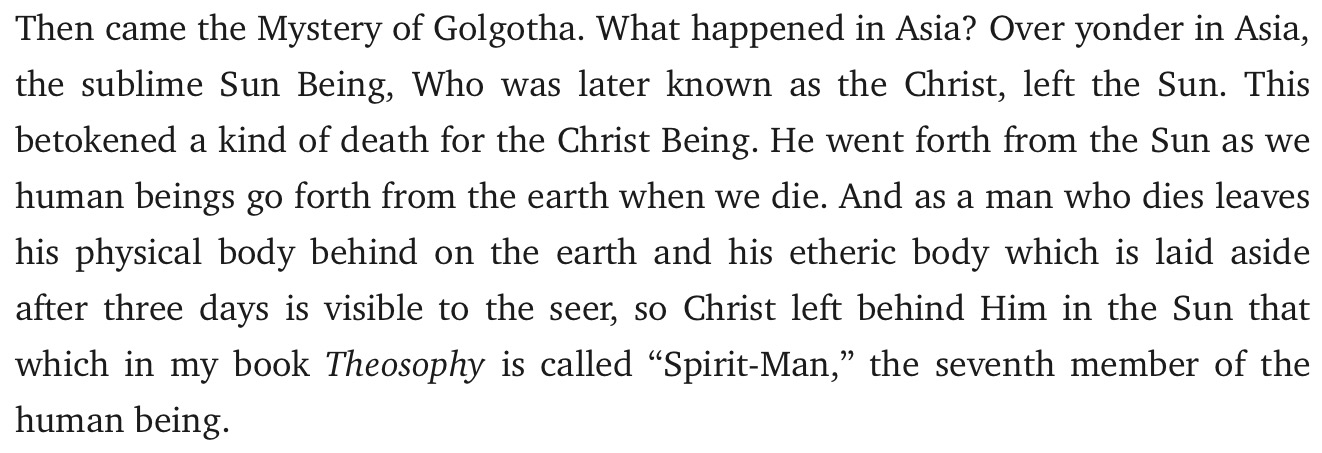
Here he receives the Buddhi:

And:

The soul of the First Logos entered Jesu Soul at thirteen and before the Baptism it leaves the soul again.
John the Baptist represented the old Adam Kadmon, he pointed on to the next. John was beheaded, separating body and head, splitting the upper and lower principles of the old Adam. After this he hovers above the disciples, as the spirit of the First Logos.
The incarnating Third Logos:

The Running Youth
When the running youth left Jesus, it was the First Logos who left. Jesus died and entered the death world, the astral world, as the Third Logos.
We see it again at the grave.
Zarathustra and Lazarus

The Zarathustra soul Steiner mentions is the First Logos and Lazarus the Second Logos:
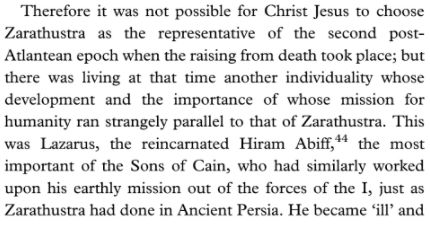
Here give Christ over to Lazarus John, the Second Logos, mentioning the relationship between Zarathustra and Lazarus.

The Second Logos is represented by John the Evangelist who leaves the cave, Earth, to become the teacher and leader of humankind, the Temple Builder, replacing the John the Baptist.

It’s interesting that the Second Logos, Lazarus, ascends from the grave and the Third Logos disappears into the grave, becomes one with the Earth.
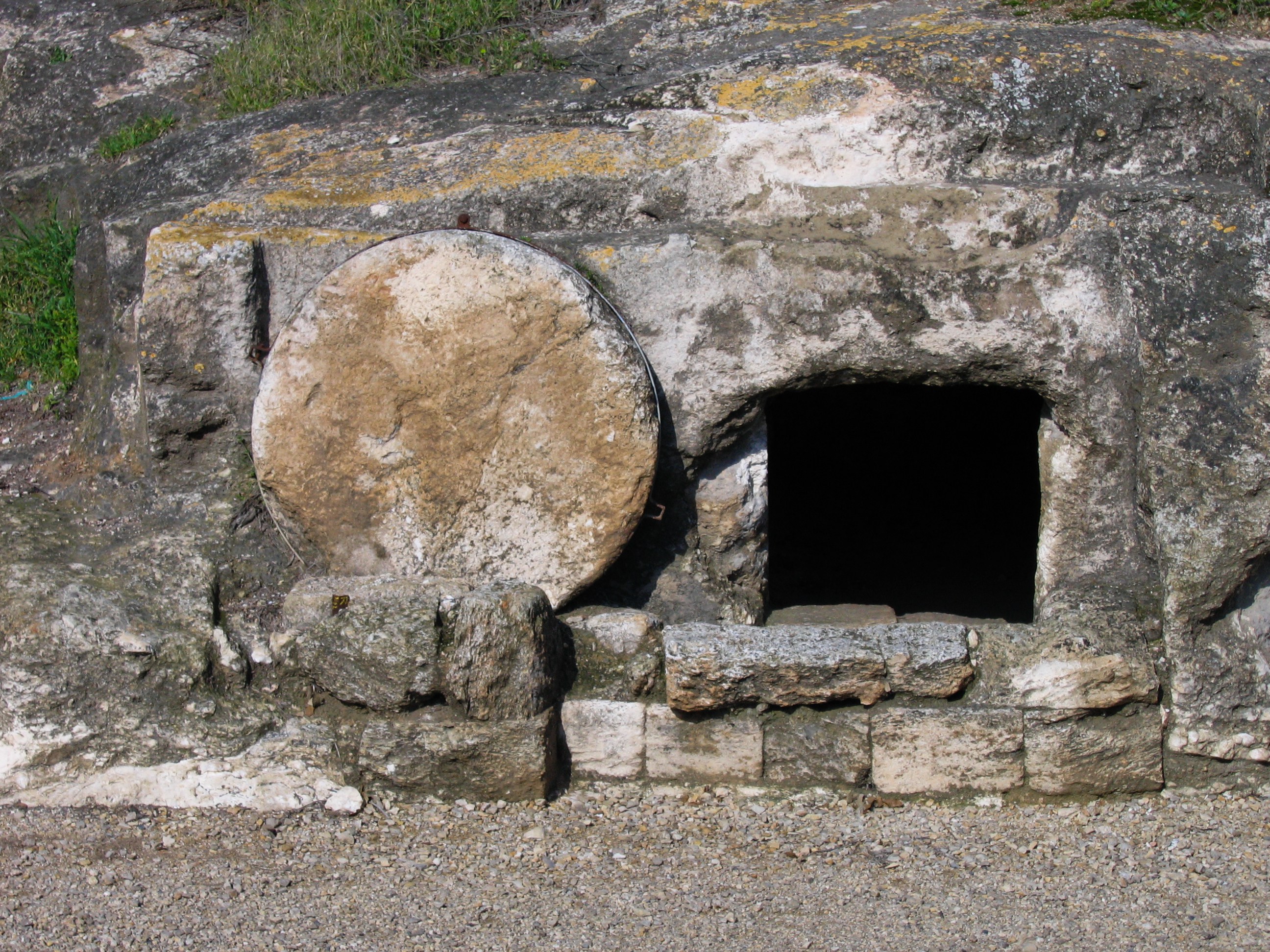
The Second Logos takes over, and he becomes the author of the Gospel of John and the Apocalypse of John:
“Under the Cross stood the mother of Jesus, Sophia.”
To this mother Jesus says:
“Woman, behold thy son.”
He himself had transferred the Sophia that lived within him to the Disciple John; he transformed him into a son of Sophia and said:
“Henceforth you should recognise the divine wisdom as
your mother and dedicate yourself to her alone.”
John had recorded this divine wisdom; Sophia is embodied in the Gospel of St. John.
Jesus had given him this wisdom, and he was authorized by Christ to transmit it to the world. ~Steiner
In 1879 Anthroposophia raised from Angel to Archangel, and as she was the Logos of the Angels, the Second Logos, she took the vacant seat of Michael.
A deeper view on the creative process of the Three Logoi can be found in Why are there so much pain on Earth?.

The Three Logoi

The history of the current Second Logos is a very long and interesting story, and I am working on it.

Who are Gilgamesh and Enkidu
Posted by Kim Graae Munch in Esoterics, Rosicrucianism on June 4, 2010
Who are Gilgamesh and Enkidu
There are at least two levels or stories in this epos. There are the story about two human beings and their endeavors, and there is the story about mankind, where Enkidu symbolizes the sentient soul and Gilgamesh the Mind soul, the Ego.
On the personal plane we learn through Enkidu the descent into the physical plane and through Gilgamesh the ascent up from the physical plane.
I will here try to find the deeper aspects of these beings in the esoteric history of man, looking at them as persons and as symbols. The first part will mainly build on Rudolf Steiner’s “Occult History” lectures 1 and 2, concentrating on the persons of Gilgamesh and Enkidu, or Eabani as Steiner calls him. In the second part I will look at the events on the spiritual plane to show their symbolic nature.
From Occult History by Rudolf Steiner
In Occult History Rudolf Steiner tells:
These beings are the highest developed persons within the human wave, and already on the old Moon were they selected for their part in the development of Earth. We know them as the twelve Bodhisattvas, the seven Sages, and as Christian Saints.
In the start of the second lecture RS elaborates on this theme:
This is the definition of the Bodhisattvas and their helpers, who are guiding the human history through the recurring crises caused by the powers of resistance.
The Gilgamesh epic is a remarkable myth, describing the esoteric path as it is until our time and written as it was written for us.
The myth describes the development until the initiation, which first became possible later.
Who are Gilgamesh?
As the previous quote says, Gilgamesh is a being with enormous potential.
Now Gilgamish was a personality who had many incarnations behind him and may therefore be called an “old” soul within the evolution of humanity…The souls who came down early have therefore more incarnations behind them in earth-evolution than those who came down later; hence we can call these latter, in contrast to the former, “younger” souls — souls who have taken less into themselves…
In the case of Gilgamish, the Being who was to reveal himself through him, and who could do so only by leading him presently to a kind of initiation, kept a guiding hand upon him from the outset and set him at the place where he came to recognise his own position in the history of the world…
The whole nature of an old soul will enable it early in life to grasp not only the essential element, the essential factor, in the existing culture, but also that which strikes into it as a new impulse, opening up a wide vista into the future. [2]
Gilgamesh incarnated back in Lemuria, maybe as the first of the development wave of man. Through his many incarnation he had reached a stage about where man were at the time of the Maid of Orleans. 2 This is one of the reasons why RS uses the word personality about him, he has developed the Ego as no other person have at this time in history, he have lost all connections to the spiritual world, and is as Ahrimanic as a man can be, as the son of Adam, Cain. His task is to form the development of the Earth, he is the archetypal Hero.
It could be understood as nephesch (sentient soul) and ruach (mind soul) are full developed, but that n’schamah (consciousness soul) is not, two out of three.
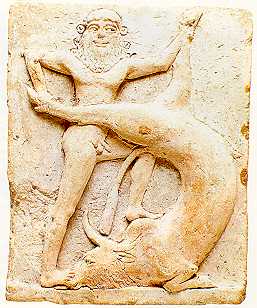 Gilgamesh – The Archetypal Hero
Gilgamesh – The Archetypal Hero
Who are Enkidu?
Enkidu (Eabani) is a diametrical different being; Enkidu is a being with few incarnation, ego-less and without karma, he lives in innocence with the animals. Through Enkidu’s encounter with a woman he acquires karma and becomes part of humanity, becomes part of civilization.
…
Eabani is depicted as being clothed in skins of animals. This is an indication of his wild nature; but because of this very wildness he is still endowed with ancient clairvoyance an the one hand, and an the other hand he is a young soul who has lived through far, far fewer incarnations than other souls who have reached a high level of development. Thus Gilgamish represents a being who was ready for initiation but was not able to attain it, for the journey to the West is the journey to an initiation that was not carried through to the end. [1]
In contrast to Gilgamesh, Enkidu is a young soul, without Ego, but with highly developed spiritual faculties, which Gilgamesh have lost. It can be said that Enkidu is the most Luciferic being born on Earth.
Enkidu’s task is to give Earth the Heavenly Wisdom to help man form the future. He is the archetypal Seer or Priest, as the son of Adam, Seth, the last born.
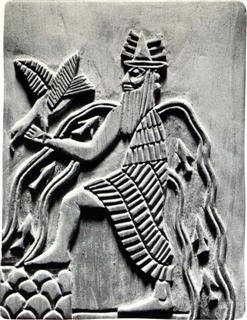 Enkidu letting wisdom stream out over the world
Enkidu letting wisdom stream out over the world
Here we see Enkidu placed as a helper for Gilgamesh, where the Luciferic Enkidu should bring equilibrium with the Ahrimanian Gilgamesh, helping him to purify humanity.
Enkidu represent wisdom.
Gilgamesh and Enkidu
These two are born again and again through history, as the bringer of Wisdom and of Form, as Teacher and Hero, as Aristotle and Alexander, or Aquinas and Christian Rosenkreutz.
In the bible we see them showing the shift from the old clairvoyance to the knew, for example as Esau (red and hairy hunter) and Jacob, or as Solomon and Hiram Abiff [Temple Legend]
The spiritual strength of these two are shown through
These great ‘personalities’ incarnates each hundred years, as Steiner describes in connection with Christian Rosenkreutz and Master Jesus, and it’s naive to believe that these big human beings only have been incarnated the few times as some seems to believe. If you read the Occult History and look for the word ‘personality’ it will point to further incarnations of these persons.
From the Gilgamesh Epic
Steiner tells that this epic describes physical reflections of the spiritual, and that should be considered in the mentioning of Ahriman and Lucifer in the following. I try here to show the two companions relation to the Ahrimanian and Luciferic, to explain their physical roles described in the previous chapter.
Gilgamesh is described as a man with all knowledge, showing him as a highly developed human being, with full control of the physical world, a doer:
The text on the stone states that he is two third god and one third human, king and super human, but he oppresses his people harshly, uses his power egoistically for his own satisfaction.
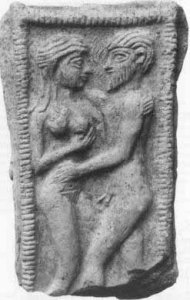 The people call out to the sky-god Anu, the chief god of the city, to help them. In response, Anu creates a wild man, Enkidu, out in the harsh and wild forests surrounding Gilgamesh’s lands. This brute, Enkidu, has the strength of dozens of wild animals; he is to serve as the subhuman rival to the superhuman Gilgamesh.A trapper’s son, while checking on traps in the forest, discovers Enkidu running naked with the wild animals; he rushes to his father with the news. The father advises him to go into the city and take one of the temple harlots, Shamhat, with him to the forest; when she sees Enkidu, she is to offer herself sexually to the wild man. If he submits to her, the trapper says, he will lose his strength and his wildness.
The people call out to the sky-god Anu, the chief god of the city, to help them. In response, Anu creates a wild man, Enkidu, out in the harsh and wild forests surrounding Gilgamesh’s lands. This brute, Enkidu, has the strength of dozens of wild animals; he is to serve as the subhuman rival to the superhuman Gilgamesh.A trapper’s son, while checking on traps in the forest, discovers Enkidu running naked with the wild animals; he rushes to his father with the news. The father advises him to go into the city and take one of the temple harlots, Shamhat, with him to the forest; when she sees Enkidu, she is to offer herself sexually to the wild man. If he submits to her, the trapper says, he will lose his strength and his wildness.
Shamhat meets Enkidu at the watering-hole where all the wild animals gather; she offers herself to him and he submits, instantly losing his strength and wildness, but he gains understanding and knowledge. He laments for his lost state, but the harlot offers to take him into the city where all the joys of civilization shine in their resplendence; she offers to show him Gilgamesh, the only man worthy of Enkidu’s friendship. [3]
Here Enkidu incarnates to be the helper and companion of Gilgamesh. He is shown in his pre-human state running wild with the animals, and how he becomes human through creating karma, through lust for living.
The woman Shamhats power is thinking and forming where Enkidu lived in wisdom. Six dayes and seven nights hints at the seven chakras who are prepared for the life on Earth.
He is like a good now, he have become a sentient being, conscious of his own I. He wants to rule over Gilgamesh, but the courtesan told him that Gilgamesh, the Ego, the mind soul, was stronger than Enkidu, the sentient soul. These two soul-bodies are joined together, and even to this day they fight each other, only the day that they don’t fight each other, are they released.
 Separation of the sexes – Twin Soul Aspects – Dual’s
Separation of the sexes – Twin Soul Aspects – Dual’s
He enters the Earth fully:
Cooked food, bread, and wine all weight the physical body down, binding the etheric body to the physical body.
 Enki. About 2,500 BCE. Note the image of planets revolving around the Sun!
Enki. About 2,500 BCE. Note the image of planets revolving around the Sun!
The sentient soul were the connection to the spiritual world, and wisdom, at that time. Here we also see the descent into the physical.
Here Enkidu gave tribute to Gilgamesh, representing the mind soul. The next tells about the sacred marriage between the sentient and mind soul, or the etheric and physical body:
The language of Gilgamesh, from his prophetic dreams (“I loved [Enkidu] and embraced [him] as a wife”) to the bridal bed in Uruk — Enkidu’s in retrospect — clearly refers to a “sacred marriage“: the spiritual union or blending of the inner and outer man. None of the extant material names a victor, but the Old Babylonian story given above suggests that the initial strife or “wrestling” is brought to an abrupt end by mutual recognition: Gilgamesh “bent his knees” (to Enkidu’s stature) and “planted his foot in the ground.” Both phrases are apparent wordplays on Enkidu’s name, indicating a successful (or “victorious”) bonding and assimilation. Enkidu’s subsequent acknowledgment and friendly embrace with Gilgamesh confirm their acceptance of the relationship.Up to this point the story has been prologue — an allegory about the evolution and creation both of mankind and of a truly human individual. From here on Gilgamesh and Enkidu go as one, faithful to each other until death. In the Sumerian stories, Enkidu remains the servant of Gilgamesh; in the Babylonian version, Gilgamesh’s mother adopts Enkidu — he becomes not only the servant, companion, and friend of Gilgamesh, but also his younger “brother.” Viewed as a single composite character, Gilgamesh-Enkidu represents the conjoining of heaven and earth, of spirit, soul(s), and body, in a full sevenfold partnership (5) necessary for one to succeed in the hero’s quest. [4]
The one tells that the sentient soul (Enkidu) is below (sevant of) the mind soul (Gilgamish), where he is a younger brother in the other tradition.
With Humbaba the terrible we are in Eden and he is known by Enkidu, which means they are related, and he guards the trees of wisdom and life. Enkidu, representing the Luciferic wisdom, is not ready to fight the Ahrimanic spirits, so he works against Gilgamesh.
This is part of the life of man, going through the twelve signs of the Zodiac:
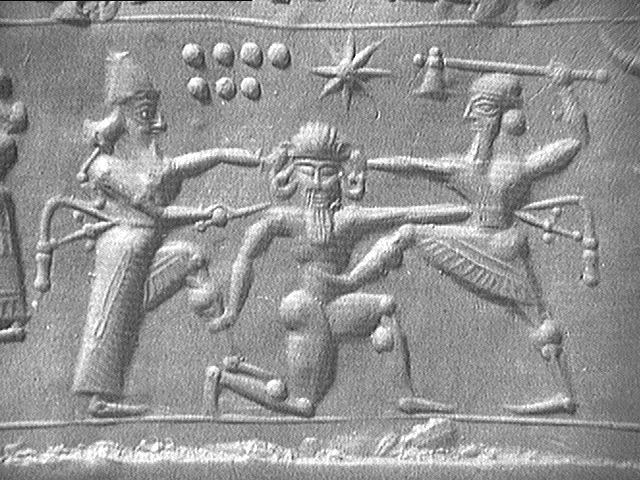 Gilgamesh and Enkidu with Humbaba
Gilgamesh and Enkidu with Humbaba
…
As Gilgamesh and Enkidu approached the forest, their trepidation grew. Shamash sent a message from the sky: “Humbaba has removed six of his seven cloaks. … They saw the height of the Great Cedar. Where Humbaba walked, a path was made. The road was good… [4]
The seven is connected to the chakras, and the seven-terrored was the chakras to clean. The path is the path of Karma.
On the six days travel (and seven nights?) Enkidu interprets the dreams of Gilgamesh, demonstrating that he is closer to the spiritual world. On the entrance to the Cedar Forrest:
Gilgamesh wins over Lucifer/Enkidu and they work together against Ahriman.
Here the Ahrimanic Humbaba tries to split the two, but Enkidu now inspires Gilgamesh with courage. When man has won his fight with Lucifer, he works as helper for man, as a holy spirit.
Here again Enkidu/Lucifer helps Gilgamesh against the Ahrimanic, which on it’s side bans the Luciferic from the physical plane. Enkidu dies, separates man from the spiritual, which introduces death, as man no longer remember his previous lives. The Sentient soul looses it’s sight into the spiritual world, the end of the old clairvoyance.
 Shamash (the Sun) between Mashu’s Twin Peaks,
Shamash (the Sun) between Mashu’s Twin Peaks,
Akkadian, 3rd millennium BC (British Museum)
He now starts his journey on the pure physical plane incarnating through the twelve star signs:
 Ziggurat in the Eanna Sector at Uruk (Andre Parrot, Sumer)
Ziggurat in the Eanna Sector at Uruk (Andre Parrot, Sumer)
References
1. Rudolf Steiner: Occult History, Lecture 1;
2. Rudolf Steiner Occult History, Lecture 2;
3. Richard Hooker Mesopotamia Gilgamesh Summary, Washington State University;
4. W. T. S. Thackara The Epic of Gilgamesh: A Spiritual Biography
Full text of Gilgamesh Epic, Gilgameš, Enkidu and the nether world.
- The Temple Legend by Rudolf Steiner
- The Masonic Legend by Max Heindel
- The Hiramic Legend by Manly P. Hall
Use back-button to go back to text!
Map


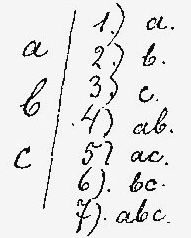






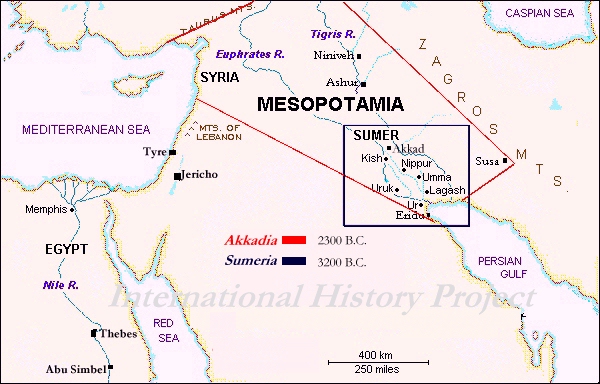
![kimgraaemunch [] GMail () com](https://kimgraaemunch.files.wordpress.com/2017/02/kimgraaemunch-g.png?w=210)












